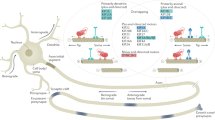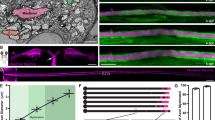Abstract
When living axons are examined in the light microscope many of the membrane-bounded organelles they contain can be seen to undergo rapid saltatory movements, predominantly in the retrograde direction1. This is thought to be an important component in the fast transport of materials in axons, the mechanism of which is unknown although cytoskeletal elements such as actin filaments and microtubules are probably involved (see ref. 2 for review and refs). I describe here experiments in which giant axons from the legs of the crab Carcinus maenas have been made permeable to ions and small molecules using a high voltage discharge to puncture holes in the plasma membrane3. This allows, in a suitable buffer, movement to be arrested due to the loss of metabolites and then reactivated by the addition of exogenous ATP, thus showing directly for the first time that rapid saltatory motion in axons is an ATP-requiring process.
This is a preview of subscription content, access via your institution
Access options
Subscribe to this journal
Receive 51 print issues and online access
$199.00 per year
only $3.90 per issue
Buy this article
- Purchase on Springer Link
- Instant access to full article PDF
Prices may be subject to local taxes which are calculated during checkout
Similar content being viewed by others
References
Cooper, P. D. & Smith, R. S. J. Physiol., Lond. 242, 77–79 (1974).
Grafstein, B. & Forman, D. S. Physioi. Rev. 60, 1167–1283 (1980).
Baker, P. F. & Knight, D. E. Nature 276, 620–622 (1978).
Collins, F. Devl Biol. 65, 50–57 (1978).
Smith, R. S. Soc. Neurosci. Abstr. 3, 31 (1977).
Lienhard, G. E. & Secemski, I. I. J. biol. Chem. 248, 1121–1123 (1973).
Cande, W. Z. & Wolniak, S. M. J. Cell Biol. 79, 573–580 (1978).
Gibbons, I. R. et al. Proc. natn. Acad. Sci. U.S.A. 75, 2220–2224 (1978).
Macara, I. G. Trends biochem. Sci. 5, 92–94 (1980).
Baker, P. F. & Knight, D. E. Phil Trans. R. Soc. B296, 83–103 (1981).
Williamson, R. E. J. Cell Sci. 17, 655–668 (1975).
Author information
Authors and Affiliations
Rights and permissions
About this article
Cite this article
Adams, R. Organelle movement in axons depends on ATP. Nature 297, 327–329 (1982). https://doi.org/10.1038/297327a0
Received:
Accepted:
Issue Date:
DOI: https://doi.org/10.1038/297327a0
This article is cited by
-
Active biological mechanisms: transforming energy into motion in molecular motors
Synthese (2021)
-
Kinesin: Its properties and possible functions
Protoplasma (1988)
-
Neurofilament degradation in the nervous system of rats intoxicated with acrylamide, related compounds or 2,5-hexanedione
Archives of Toxicology (1988)
-
Calcium localization in nerve fibers in relation to axoplasmic transport
Neurochemical Research (1984)
-
Rapid transport of foreign particles microinjected into crab axons
Nature (1983)
Comments
By submitting a comment you agree to abide by our Terms and Community Guidelines. If you find something abusive or that does not comply with our terms or guidelines please flag it as inappropriate.



